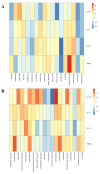Silymarin Modulates Microbiota in the Gut to Improve the Health of Sow from Late Gestation to Lactation
- PMID: 36077922
- PMCID: PMC9454421
- DOI: 10.3390/ani12172202
Silymarin Modulates Microbiota in the Gut to Improve the Health of Sow from Late Gestation to Lactation
Abstract
Inflammatory responses reduce milk production in lactating sows. Silymarin may modulate inflammatory reactions. Here, we aimed to verify whether dietary silymarin supplementation could alleviate inflammatory responses in lactating sows through microbiota change in the gut. We also investigated how silymarin impacts inflammatory response in lactating sows. One hundred and ten sows were randomly assigned to a control diet (basal diet) or treatment diet (basal diet and 40 g/d silymarin) from the 108th day of gestation to weaning. Blood, milk, and feces from sows were collected for analysis. It was shown in the results that dietary silymarin supplementation decreased the level of pro-inflammatory cytokine IL-1β (p < 0.05) on the 18th day of lactation in the blood of the sows. Dietary silymarin supplementation tended to decrease (p = 0.06) somatic cell count in the colostrum of sows. Dietary silymarin supplementation reduced the gut bacterial community and the richness of the gut microbial community (p < 0.01) using 16S rRNA gene sequencing. The fecal microbes varied at different taxonomic levels in the lactating sows with silymarin supplementation. The most representative changes included an increase in the relative abundance of Fibrobacteres and Actinobacteria (p < 0.05) and tended to reduce the relative abundance of Spirochaetaes and Tenericutes (p = 0.09, 0.06) at the phylum level. It is suggested that dietary silymarin supplementation in late gestation until lactation has anti-inflammatory effects in lactation sow, which could be associated with the modulation of gut microbiota.
Keywords: inflammation; microbiota; silymarin; sow.
Conflict of interest statement
We certify that there is no conflict of interest with any financial organization regarding the material discussed in the manuscript.
Figures







References
-
- Jiang X., Lin S., Lin Y., Fang Z., Xu S., Feng B., Zhuo Y., Li J., Che L.Q., Jiang X.M., et al. Effects of silymarin supplementation during transition and lactation on reproductive performance, milk composition and haematological parameters in sows. J. Anim. Physiol. Anim. Nutr. 2020;104:1896–1903. doi: 10.1111/jpn.13425. - DOI - PubMed
LinkOut - more resources
Full Text Sources

